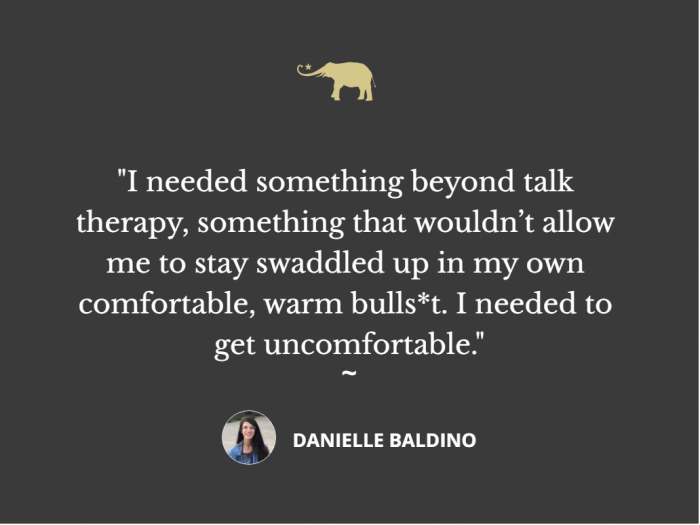I was introduced to Accelerated Experiential Dynamic Psychotherapy (AEDP) through a book recommended to me by the therapist we were seeing for premarital counselling.
The book was called It’s Not Always Depression by Hilary Jacobs Hendel, and this struck a chord with me because I was currently contemplating—after almost four years off the stuff—going back on my SSRI antidepressant.
In fact, after a three-minute phone conversation with a doctor I had never met before, I had a shiny new bottle of 90 tablets sitting in my medicine cabinet, calling to me every morning: “Will today be the day? Have you had enough of this yet?”
With nothing left to lose, I decided to give this book, and AEDP, a shot.
I have been on a journey of “doing the work” for a couple of years now. This journey started about a year into my sobriety, when I woke up one day and realized I felt worse than I ever had before. I had ripped off the alcohol Band-Aid but didn’t have anything to replace it. My wounds were left open, unprotected, and oftentimes, getting worse.
I had spent most of my adult years in therapy, and I figured I could talk my way through my issues. However, I quickly realized that I was in the habit of manipulating those sessions: I would people-please the therapist, saying what I thought they wanted to hear. I would skew a story so that they would agree with and validate my reaction. Sometimes, I would talk just to hear myself talk and feed my emotional addiction, reliving painful experiences without any real resolution. All of these were trauma responses, and they were hindering any real progress. I needed something beyond talk therapy, something that wouldn’t allow me to stay swaddled up in my own comfortable, warm bulls*t. I needed to get uncomfortable.
My first foray into the uncomfortable was a 12-step program. I was forced to look inward, to make a literal list of resentments and see “my part” in those events, and to make amends with those I had hurt. There was something incredibly relieving in the humility of it all; I was finally able to drop the act. I was almost eager to seek out opportunities to apologize or “see my part” in things. But, eventually, like talk therapy, the 12 steps only got me so far. I was sick of constantly making amends for my emotional outbursts and began seeking a more preventative measure.
I stumbled upon attachment theory a few years ago and started to see my patterns in a new light. At first, I was relieved—there was a why to my behavior! But then I was almost immediately depressed and overwhelmed by the level of work there was to be done. I shut down for a few months, even backslid a bit. When it was the right time, I eventually started doing attachment work: catching myself in moments of panic or fear, self-soothing myself with visions of my inner child, journaling about all the ways in which I felt loved, and practicing intense self-care and self-compassion.
Yet again, I found myself at a plateau—I wasn’t looking forward to a life caught up in the cycle of over-reactivity followed by reluctant journaling and aggressive attempts to convince myself I was loved and worthy. I was still seeking the root of the cycle. Something I could turn to when the emotions first emerged, not just a salve I could apply after the fact. But I was also exhausted: although my emotional flare-ups were fewer and further between, they still shook me to my core and brought up feelings of hopelessness and “I can’t ever change”-ness. Maybe it was just me. Maybe I was just depressed. Enter the bottle of antidepressants, staring me in the face each day.
The goal of AEDP, in Hendel’s view, is to get to an openhearted state, in which we encompass the “7 Cs”: clear, calm, connected, confident, compassionate, courageous, and curious. Reading about this was exciting—it was exactly where I had wanted to be for the last several years! But to get there would require more digging: Hendel’s concept of AEDP is an upside down triangle, which she has aptly dubbed “The Change Triangle.” Imagine the openhearted state, but on top of it is everything we must sift through to get there.
On the lower point of the triangle, we have our seven core emotions: sadness, disgust, excitement, sexual excitement, anger, fear, joy. Ideally, we go between feeling and processing these emotions in full, then bouncing right back to the openhearted state. But when we don’t or can’t feel these emotions because of potential conflict or their overwhelming intensity, we rush to our blocking, or “inhibitory,” emotions of anxiety, guilt, and shame—the right upper corner of the triangle.
When these inhibitory emotions become too much to bear, we slide over to the left upper corner: defenses. This is checking out on your cell phone, nervous laughter, shutting down, spacing out, passing judgement, talking too much, sex, drinking or drug use, etc. And so the cycle continues, keeping us caught between defenses and blocking emotions, cut off from our core emotions which then remain “stuck” in our nervous system, and living light-years away from our openhearted state.
There are a few ways to “work” this triangle. In a moment of anxiety or guilt, or getting caught up in a defense state, recognizing what’s happening for you is the critical first step. You can take a moment to draw the triangle to figure out what corner you are: defense, inhibitory emotion, or a core emotion. Then work backward to process your core emotion: scan your body to see which of the seven core emotions you are feeling. Feel it fully, listening to your body, then—eventually—drop back into the openhearted state.
Example: I catch myself mindlessly scrolling on Instagram following argument with my partner (a defense behavior). I put the phone down and realize I feel anxious (an inhibitory emotion). I close my eyes, take a few deep breaths, drop in, and scan my body for seven core emotions, settling on “fear” and “anger” (my current core emotions). I let myself feel those emotions fully, crying or screaming if I must. I do this until I have processed it fully, then I calm myself down with deep breathing or visualization practice, returning eventually to my openhearted state.
Another way to work this is through meditating on the first time you felt this emotion, and then fantasizing a different way for it to play out. Example: I feel snubbed at work and am carrying around a heavy resentment. I close my eyes and get in touch with this emotion—maybe anger, disgust, fear—and I am suddenly reminded of a time my dad shut me down when I tried to protest playing softball. I felt invalidated and unimportant, and that’s exactly how I feel at work.
I fantasize that, as a child, adult me enters the picture and sets my dad straight, validating my inner child’s protests and concerns, perhaps holding and protecting her, reminding her that she is special and that her boundaries are valid and important. In this way, the memory becomes just something that happened—no longer a “live wire” as Hendel puts it in her book, a searing electrical current waiting to reignite at any sign of controversy in my adult life.
In this way, I am not only soothing myself from the painful emotions in my work scenario, but also deactivating the memory that laid the groundwork for the fear and reactivity to begin with. With time and practice, this becomes a proactive and preventative measure to help build my resilience to similar “snubbing” issues in the future.
You can also find a trained AEDP therapist near you or virtually and work through traumatic experiences and The Change Triangle together. This is especially helpful if you are having a hard time naming emotions or feeling into your body, both of which are common trauma responses.
AEDP has worked wonders for both my recovery and my emotional sobriety. It offers a tangible tool that I can turn to in a moment of overwhelming emotion. It has been the glue that brings all my previous work together: the practice is validating in and of itself, and I am finally able to do meaningful inner child work. AEDP also helps me to make sense of embodiment and really drop into what my body is feeling and desiring in any given moment. It acknowledges all my past experiences and, instead of hefting them onto my shoulders as “more work to do,” it helps me to diffuse their lingering effect on me. For once, I feel finally free from the cycle.


 Share on bsky
Share on bsky





Read 4 comments and reply